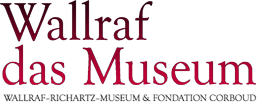
Entrance of the exhibition . Photo: Rheinisches Bildarchiv


The display rooms, arranged by six chapters, radiate from the centre of the exhibition. Photo: Rheinisches Bildarchiv


Chapter 1 - What Is an Impression? On 25 April 1874, from one day to the next, the word impression became the buzzword in the French art world. It refers, in particular, to a sensory impression, and it gave its name to an art movement which is doubtless among the most popular today. The occasion for its sudden fame was the first joint exhibition by a group of young artists whom the critic Louis Leroy contemptuously dismissed as Impressionistes. Leroy took the word from the title that Claude Monet had himself given one of his pictures: Impression - soleil levant / Impression - Sunrise. What Leroy and other critics found so bad about many of these artists' pictures was above all the sketchy manner and the unfamiliar colourfulness of the paintings. For the artists, it was precisely these qualities that summed up the leitmotif of their art. For them what played the major role was "seeing", pure and simple, the colourful reproduction of sensory impressions obtained in the open air. And they referred in the process to the latest research into optics and colour perception. It is true that hardly anyone knew this, because the results of this research still had to be made public. When increasingly they did become known, in the course of the 1880s, the Neoimpressionists were already on their heels. For them, it was a matter of principle to unite art with all the insights of science in order to perfect the painted impression. Photo: Rheinisches Bildarchiv


Chapter 1 - What Is an Impression? Experiment demonstrating the effect of additive colour combination. Photo: Wallraf-Richartz-Museum & Fondation Corboud


Chapter 1 - What Is an Impression? Experiment demonstrating the effect of the origin of coloured shadows. Photo: Wallraf-Richartz-Museum & Fondation Corboud


Chapter 1 - What Is an Impression? Monet's Haystack series has become one of the icons of Impressionism. The experience that light effects not only change from hour to hour but also depending on the season of the year was one that the Impressionists had made a long time before. But Monet like no other was fascinated by the way nature changed in natural sunlight and sought to capture the various natural lighting conditions. The exhibition visitor had the chance to put himself in Monet's place and to watch two haystacks on a time lapse film over the course of a late summer's day. Photo: Rheinisches Bildarchiv


Chapter 2 - What did the Impressionists Paint With? When the Impressionists wanted to paint, and needed canvas and paints for the purpose, it already went without saying that they visited a specialist supplier. By 1850 there were 276 colour merchants in Paris alone. These marchands de couleurs sold not only paints, but mostly also all the other things a painter needed. Their product range reflected industrial and scientific progress. Canvases of all kinds for example could now be produced by machine. These, along with wood panels and picture supports made out of the newly introduced "artists' board" were available in standard sizes, and, being pre-primed, were ready for use. Of overwhelming importance was the invention of numerous new pigments of hitherto unknown intensity and brightness. They allowed artists' paints to be industrially produced instead of having to be mixed by hand. The metal tube, invented in 1842, guaranteed the airtight storage and easy transport of ready-to-use oil-paints for the first time. In addition, the shops were filled by brushes in new shapes and numerous other aids. The Impressionists nurtured close contacts with their colourmen, many of whom returned the compliment by displaying the Impressionists' pictures in their shop-windows. Photo: Rheinisches Bildarchiv


Chapter 2 - What did the Impressionists Paint With? Photo: Rheinisches Bildarchiv


Chapter 2 - What did the Impressionists Paint With? Photo: Rheinisches Bildarchiv


Chapter 3 - Inside or Outside? Even though the Impressionists didn't invent open-air painting, it is their characteristic hallmark. This is demonstrated by gardens and parks in bloom, coastal views and riverscapes: it was natural daylight that illuminated their stage. What we can be less sure of, however, is where and how exactly their pictures took shape. For in practice, painting in the open-air was not so romantic as the pictures may make it seem. How for example should we imagine an artist painting in the snow? Did the Impressionists really work in the open air, braving cold and heat, wind and weather in the process? To capture the atmosphere outside, wasn't it enough just to look out of the studio window, or maybe venture on to the balcony or into the garden? Nor is there any doubt that the Impressionists had dealings with photography, which had been recently invented; but what was its precise role? Neither the painting technique nor the picture that we actually see can tell us whether a scene was painted outdoors or in the studio. But the paintings themselves do provide reliable clues which can be discovered with a bit of detective work. Photo: Rheinisches Bildarchiv


Chapter 3 - Inside or Outside? Photo: Rheinisches Bildarchiv


Chapter 3 - Inside or Outside? Photo: Rheinisches Bildarchiv


Chapter 4 - Spontaneous or Strategic? There is plenty of evidence that while the Impressionists in general approached their work spontaneously, the Neoimpressionists took a strategic view. But what about individual pictures? Answers to this question can be provided by examining the paintings under the microscope, or using infrared or x-ray techniques. These procedures enable us to look deep into, or even right through, the pictures. Thus we learn for example something about the working process. Did the Impressionists take up their brush and palette spontaneously, or did they first carefully plan their compositions? What other aids did they use? And what do the drawings, for example, that we often find beneath the layer of paint tell us about the works of the Impressionists and their successors? As shown in the first sections of the exhibition, the Impressionists used the latest methods in their dealings with colour and light. This influenced their choice of painting materials and above all the development of new painting techniques. Only on very close inspection can we discover the sophistication that was brought to bear. But what did the artists do if they didn't like the result? Here too, our investigations can provide some answers. One thing however is obvious: they sought and strove for perfection. Photo: Rheinisches Bildarchiv


Chapter 4 - Spontaneous or Strategic? Photo: Rheinisches Bildarchiv


Chapter 4 - Spontaneous or Strategic? The Drawbridge is one of van Gogh's masterpieces. With virtuoso brush-strokes in striking colours, the artist captured the scene on canvas in just a few hours. You may therefore be surprised to learn that this of all pictures was thoroughly planned in advance. The bridge structure itself had already formed part of studies. And just as in the Bridge at Clichy, van Gogh used the "perspective frame" as an aid. Infrared radiation reveals further pencil lines, with which he outlined important areas of the picture. But as if this wasn't enough, van Gogh then took a brush and brown Indian ink to draw every detail. Photo: Wallraf-Richartz-Museum & Fondation Corboud


Chapter 5 - When was a Painting Complete? This was a question which particularly concerned the Impressionists' critics. From the outset, they accused the young artists of poor execution and of leaving their works unfinished. In order to understand this criticism, we must look at the "rules" of art in force at the time. A decisive part in their "enforcement" was played, in France, by the Academy of Fine Arts in Paris. By its standards, a picture counted as finished when all of its parts were evenly executed, the paint surface had been smoothed out, and the light and shade were gently modelled. A kind of finishing touch was provided by the concluding act of varnishing, which was intended to even out any remaining roughness and give the whole painting a homogeneous sheen. A signature had long been taken for granted: it provided not only the proof of authenticity and originality, but also definitively announced: "This picture is now finished". To what extent did the Impressionists depart from these rules? What was their reason for painting pictures that were dismissed as sketches? Why did they increasingly renounce the use of varnish and - more often than is apparent at first sight - also fail to sign their pictures? Today there are only a few rare originals and a reconstruction to show what the Impressionists themselves saw as the "final touch": a new way of framing and hanging their works. Photo: Rheinisches Bildarchiv


Chapter 5 - When was a Painting Complete? Photo: Rheinisches Bildarchiv


Chapter 6 - How do we See the Pictures Today? No picture is now in the state in which it left the artist's studio. But what has changed? Or, often enough, what has been changed? There are no simple answers to these questions. Mostly we do not have the documentary, let alone pictorial, evidence to tell us what the paintings originally looked like. Only careful examination allows us to identify the discrepancies between then and now. Here one can examine individual works to understand how painting materials age naturally in the course of time, and we can make some amazing comparisons. How, for example, do one detect changes that were made not by the artists themselves, but by some other hand at a later date? The kind and extent of these interventions shed light on how people saw, or wanted to see, the art of the Impressionists and Postimpressionists in the past. And what conclusions can we reach when works by these artists were not only deliberately altered, but faked in their entirety? Today's examination methods, together with our knowledge of the Impressionists' painting materials and techniques, are however helpful not just when it comes to revealing allegedly genuine works as fakes; if we're lucky, they can also contribute to the discovery of hitherto unknown originals. Photo: Rheinisches Bildarchiv


Chapter 6 - How do we See the Pictures Today? Photo: Rheinisches Bildarchiv


Chapter 6 - How do we See the Pictures Today? Genuine or Fake? Until recently, a painting of the Wallraf collection was thought to be one of two versions, painted by Monet in 1885, of a scene on the banks of the Seine near Port-Villez. So how do we know that it is in fact not by Monet, but a fake? And who painted this hitherto unknown portrait of a woman? The manner in which the paint was applied, along with an initial "M." which can be recognized with the naked eye, are clear pointers to Edouard Manet.Photo: Wallraf-Richartz-Museum & Fondation Corboud


Frontage of the Wallraf-Richartz-Museum & Fondation Corboud with exhibition banner. Photo: Rheinisches Bildarchiv



